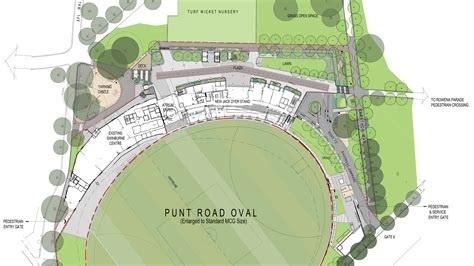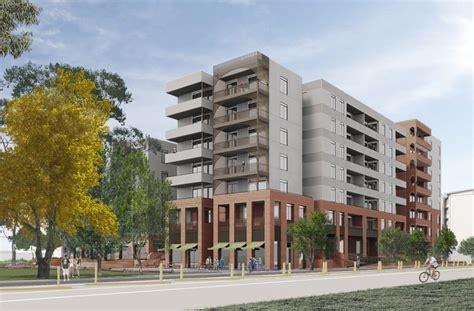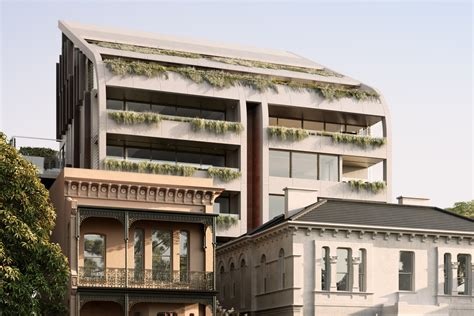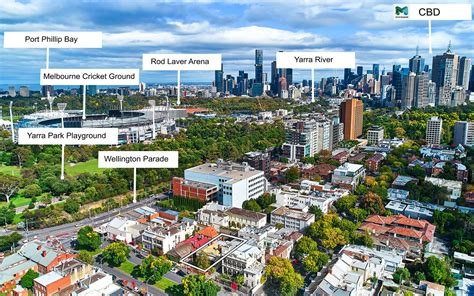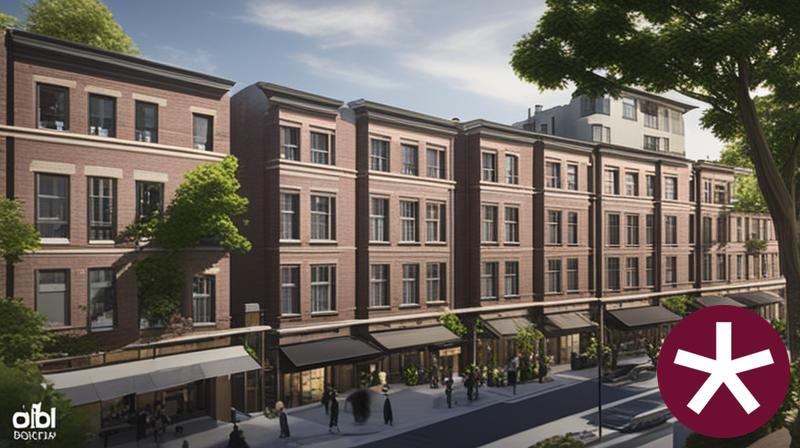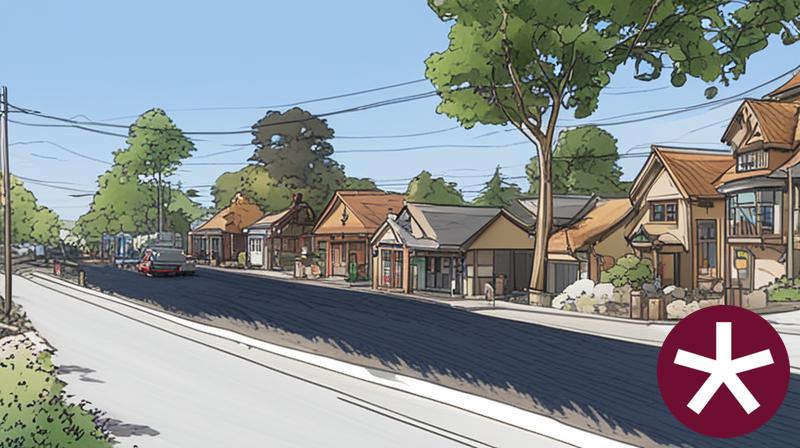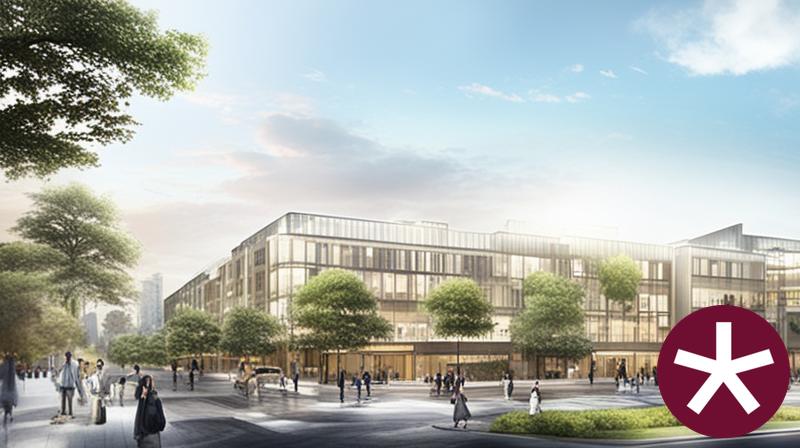Chart Color Schemes
est. as @ -- *
ABS ERP | -- people | --
2021 Census | -- people
Sales Activity
Curious about local property values? Filter the chart to assess the volume and appreciation (including resales) trends and regional comparisons, or scroll to the map below view this information at an individual property level.
Find a Recent Sale
Sales Detail
Population
East Melbourne is positioned among the lower quartile of areas assessed nationally for population growth based on AreaSearch's assessment of recent, and medium term trends
East Melbourne's population is approximately 5,215 as of August 2025. Between the 2021 Census and June 2024, it increased by 319 people to around 5,222, reflecting a growth rate of 6.5%. This increase is inferred from ABS estimated resident population data and address validation since the Census date. The population density as of August 2025 is approximately 1,798 persons per square kilometer, higher than the national average assessed by AreaSearch. East Melbourne's population grew by 6.5% between the 2021 Census and June 2024, which is within 2.1 percentage points of the national average growth rate of 8.6%. Overseas migration was the primary driver of this population increase.
AreaSearch uses ABS/Geoscience Australia projections for each SA2 area released in 2024 with a base year of 2022, and VIC State Government's Regional/LGA projections adjusted using weighted aggregation methods for areas not covered by ABS data. Based on these projections, East Melbourne is expected to have an above median population growth between 2025 and 2041, increasing from approximately 5,215 in August 2025 to around 6,036 by the end of 2041, a total increase of 821 persons and 15.9%.
Frequently Asked Questions - Population
Development
The level of residential development activity in East Melbourne is very low in comparison to the average area assessed nationally by AreaSearch
East Melbourne has seen approximately 25 new homes approved annually. Development approval data from the ABS shows a total of 129 approvals in the past five financial years, from FY20 to FY25, with no approvals recorded so far in FY26. The population has fallen during this period, suggesting that new supply has kept pace with demand, providing good options for buyers.
Commercial development remains strong, with $541.8 million in approvals registered this financial year. Compared to Greater Melbourne, East Melbourne records significantly lower building activity, at 84.0% below the regional average per person. This scarcity of new properties typically drives up demand and prices for existing ones. The area also falls short of the national average, indicating its established nature and potential planning limitations. Recent development in East Melbourne has been entirely comprised of townhouses or apartments, offering affordable entry pathways and attracting downsizers, investors, and first-time purchasers. With around 0 people per approval, it reflects a developing area.
Population forecasts indicate East Melbourne will gain 828 residents by 2041. Development is keeping pace with projected growth, although buyers may face increasing competition as the population expands.
Frequently Asked Questions - Development
Infrastructure
East Melbourne has very high levels of nearby infrastructure activity, ranking in the top 10% nationally
Changes in local infrastructure significantly affect an area's performance. AreaSearch has identified 88 projects likely to impact this region. Notable projects include Punt Road Oval Redevelopment, Greenline Project - Yarra River, 250 Albert Street, and Simpson Street Residential Development. The following list details those most relevant.
Professional plan users can use the search below to filter and access additional projects.
INFRASTRUCTURE SEARCH
Frequently Asked Questions - Infrastructure
Melbourne Arts Precinct Transformation - Southern Package (The Fox: NGV Contemporary)
The Southern Package of the Melbourne Arts Precinct Transformation focuses on the construction of The Fox: NGV Contemporary, Australia's largest gallery for contemporary art and design. The gallery will span 30,000 square metres with over 13,000 square metres of display space, featuring a dramatic 40-metre-high spherical hall, exhibition galleries, rooftop terrace and sculpture garden. Construction commenced in 2025 with Lendlease as the main contractor, part of the $1.7 billion transformation creating jobs and establishing new creative spaces in Southbank.
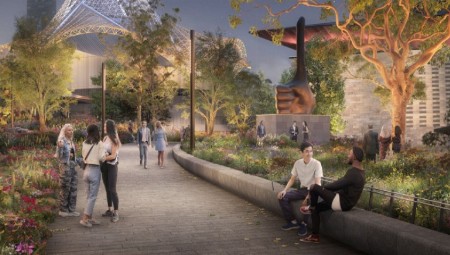
Greenline Project - Yarra River
4km transformation of Yarra River north bank from Birrarung Marr to Bolte Bridge creating continuous parkland, cycling/walking paths, new parks, upgraded public spaces, and flood protection. Largest urban renewal in Melbourne's history. The project aims to transform the Yarra River corridor with new parklands, walking and cycling paths, and environmental improvements creating a continuous green corridor from the CBD to the bay.
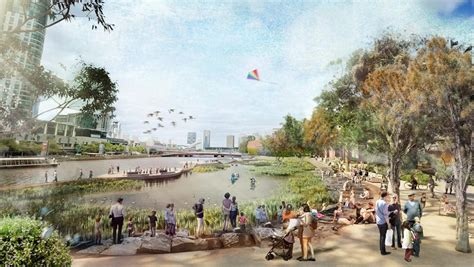
Metro Tunnel Project
The Metro Tunnel will create a new end-to-end rail line from Sunbury in the west to Cranbourne/Pakenham in the south-east, with twin 9km train tunnels connecting the east and west of Melbourne, 5 new underground stations (Arden, Parkville, State Library, Town Hall, Anzac), high-capacity signalling, and platform screen doors. Testing is underway, with the project on track to open later in 2025.
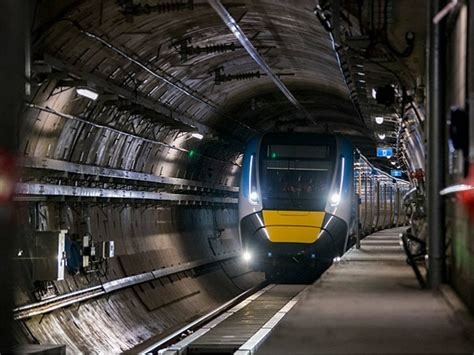
Metro Tunnel Project (Sunbury to Cranbourne/Pakenham)
Twin 9 km rail tunnels under Melbourne CBD creating a new end-to-end line linking Sunbury with Cranbourne/Pakenham, with 5 new underground stations (Arden, Parkville, State Library, Town Hall, Anzac). Testing and trial operations underway; opening targeted for late 2025 to increase capacity and bypass the City Loop with high-capacity signalling and platform screen doors.
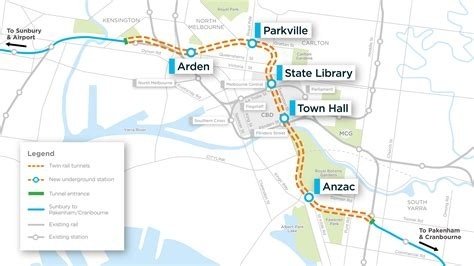
Metro Tunnel Project - Town Hall Station
A new underground station in the heart of Melbourne's CBD, providing direct access to Flinders Street Station, Federation Square, and the arts precinct. It is part of the larger Metro Tunnel project aimed at increasing capacity and reliability on the metropolitan train network.
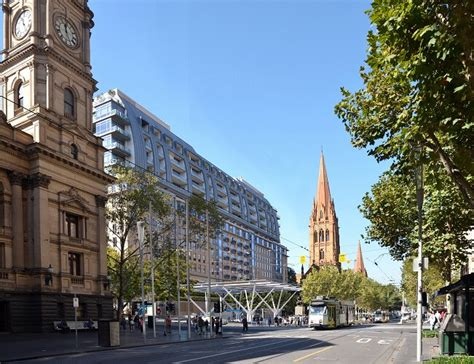
Metro Tunnel (Melbourne)
City-shaping rail line creating twin 9 km tunnels with five new underground stations (Arden, Parkville, State Library, Town Hall, Anzac). Trial operations and testing are underway with staged opening in 2025 and indications that full timetable may not commence until 2026. The project connects Sunbury to Cranbourne/Pakenham with high-capacity signalling to relieve the City Loop.
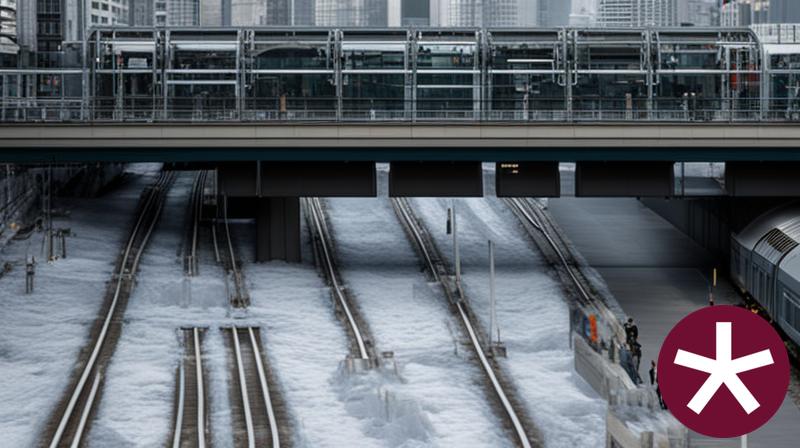
Arts Centre Melbourne State Theatre Upgrades
The refurbishment of the heritage-listed State Theatre at Arts Centre Melbourne involves significant upgrades including improved accessibility with new seating and lifts, enhanced acoustics, modernized theatre technology such as lighting and broadcast infrastructure, better air-conditioning and flooring for comfort, expanded back-of-house facilities like loading dock and rehearsal spaces, and new food and beverage areas. This is the first major upgrade since 1984, aiming to bring the venue to contemporary standards.
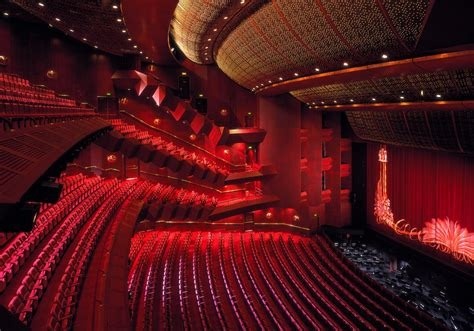
Brenan Place
A 12-level, ~12,000sqm PCA A-Grade medical office and life sciences building within St Vincent's Hospital precinct in Fitzroy. Developed by ISPT and HESTA, the project provides administrative, consulting, education and research-support space with ground-level connection to the Aikenhead Centre for Medical Discovery, extensive end-of-trip facilities, and 100% electric, 5 Star Green Star/5.5 Star NABERS targets. Structural completion (topping out) occurred in June 2025; fitout and leasing are underway.
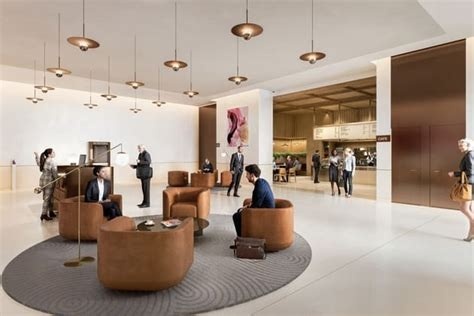
Employment
East Melbourne ranks among the top 25% of areas assessed nationally for overall employment performance
East Melbourne has a highly educated workforce with strong representation in professional services. The unemployment rate was 3.1% as of June 2025, lower than Greater Melbourne's 4.6%.
Employment growth over the past year was estimated at 6.6%. As of June 2025, there were 3,729 residents employed with an unemployment rate of 1.5% below Greater Melbourne's rate. Workforce participation was fairly standard at 69.0%, compared to Greater Melbourne's 64.1%. Key industries of employment among residents are professional & technical, health care & social assistance, and education & training.
The area specializes in professional & technical employment with an employment share of 2.1 times the regional level. Construction employs just 3.8% of local workers, below Greater Melbourne's 9.7%. There were 4.2 workers for every resident as at the Census, indicating East Melbourne functions as an employment hub attracting workers from surrounding areas. Between June 2024 and June 2025, employment levels increased by 6.6% and labour force increased by 7.1%, causing unemployment to rise by 0.4 percentage points. In contrast, Greater Melbourne saw employment rise by 3.5%, labour force grow by 4.0%, and unemployment rise by 0.5 percentage points. State-level data for Victoria as of Sep-25 shows employment grew by 1.08% year-on-year, adding 39,880 jobs, with the state unemployment rate at 4.7%. National employment forecasts from May 2025 project national growth of 6.6% over five years and 13.7% over ten years. Applying these projections to East Melbourne's employment mix suggests local growth of approximately 7.6% over five years and 15.2% over ten years, though this is a simple extrapolation for illustrative purposes only.
Frequently Asked Questions - Employment
Income
The economic profile demonstrates exceptional strength, placing the area among the top 10% nationally based on comprehensive AreaSearch income analysis
East Melbourne had a median taxpayer income of $78,074 and an average income of $175,491 in the financial year 2022, according to postcode level ATO data aggregated by AreaSearch. This is notably high compared to Greater Melbourne's median income of $54,892 and average income of $73,761 during the same period. By March 2025, estimated incomes would be approximately $85,967 (median) and $193,233 (average), based on a 10.11% growth in wages since financial year 2022. Census data shows that household, family, and personal incomes in East Melbourne rank highly nationally, between the 85th and 98th percentiles. Income brackets indicate that 30.1% of individuals earn between $1,500 and $2,999, which is consistent with broader trends across Greater Melbourne at 32.8%. Economic strength is evident as 41.7% of households achieve high weekly earnings exceeding $3,000, supporting higher consumer spending. High housing costs consume 15.4% of income, but strong earnings place disposable income at the 85th percentile nationally. The area's SEIFA income ranking places it in the 10th decile.
Frequently Asked Questions - Income
Housing
East Melbourne features a more urban dwelling mix with significant apartment living, with above-average rates of outright home ownership
East Melbourne's dwelling structure, as per the latest Census, consisted of 3.2% houses and 96.7% other dwellings (semi-detached, apartments, 'other' dwellings). This compares to Melbourne metro's 2.2% houses and 97.8% other dwellings. Home ownership in East Melbourne stood at 27.5%, with mortgaged dwellings at 18.3% and rented dwellings at 54.2%. The median monthly mortgage repayment was $2,383, higher than the Melbourne metro average of $1,962. The median weekly rent in East Melbourne was $480, compared to Melbourne metro's $396. Nationally, East Melbourne's mortgage repayments were significantly higher at $2,383 versus the Australian average of $1,863, and rents were substantially above the national figure of $375.
Frequently Asked Questions - Housing
Household Composition
East Melbourne features high concentrations of lone person households and group households, with a fairly typical median household size
Family households constitute 49.9% of all households, including 9.6% couples with children, 35.5% couples without children, and 3.3% single parent families. Non-family households account for the remaining 50.1%, with lone person households at 43.1% and group households comprising 7.1%. The median household size is 1.8 people, aligning with the Greater Melbourne average.
Frequently Asked Questions - Households
Local Schools & Education
East Melbourne performs slightly above the national average for education, showing competitive qualification levels and steady academic outcomes
East Melbourne has a notably higher proportion of residents aged 15 and above with university qualifications compared to national and state averages. Specifically, 67.4% of its residents hold such qualifications, surpassing the Australian average of 30.4% and the Victorian average of 33.4%. This high educational attainment is dominated by bachelor degrees (39.8%), followed by postgraduate qualifications (21.8%) and graduate diplomas (5.8%). Vocational pathways account for 15.8% of qualifications, with advanced diplomas comprising 9.5% and certificates making up 6.3%.
A significant portion of the population is currently engaged in formal education, totaling 20.7%, with breakdowns as follows: tertiary education (10.6%), primary education (3.1%), and secondary education (2.8%). Educational facilities within East Melbourne appear to be located outside its immediate boundaries, requiring families to access schools in neighboring areas for educational purposes.
Frequently Asked Questions - Education
Schools Detail
Nearby Services & Amenities
Transport
Transport servicing is high compared to other areas nationally based on assessment of service frequency, route connectivity and accessibility
The public transport analysis indicates that there are 54 active transport stops operating within East Melbourne. These include a mix of train, light rail, and bus services. A total of 52 individual routes serve these stops, collectively facilitating 26,228 weekly passenger trips.
The accessibility of transport in the area is rated as excellent, with residents typically located 156 meters from the nearest transport stop. On average, there are 3,746 trips per day across all routes, which translates to approximately 485 weekly trips per individual stop.
Frequently Asked Questions - Transport
Transport Stops Detail
Health
The level of general health in East Melbourne is notably higher than the national average with both young and old age cohorts seeing low prevalence of common health conditions
East Melbourne shows superior health outcomes for both young and elderly residents, with low prevalence of common health conditions. Approximately 91% of its total population (4,756 people) has private health cover, significantly higher than Greater Melbourne's 56.0%, and the national average of 55.3%. Mental health issues and arthritis are the most prevalent medical conditions in the area, affecting 8.8% and 7.2% of residents respectively.
However, 69.4% of residents report no medical ailments, compared to Greater Melbourne's 79.8%. The area has a higher proportion of seniors aged 65 and over, with 23.6% (1,229 people), compared to Greater Melbourne's 6.8%. Health outcomes among seniors in East Melbourne are notably strong, outperforming the general population in health metrics.
Frequently Asked Questions - Health
Cultural Diversity
East Melbourne was found to be more culturally diverse than the vast majority of local markets in Australia, upon assessment of a range of language and cultural background related metrics
East Melbourne has a higher cultural diversity than most local areas, with 14.9% speaking a language other than English at home and 29.1% born overseas. Christianity is the predominant religion in East Melbourne, comprising 39.7%. Notably, Judaism is overrepresented at 0.7%, compared to 0.4% across Greater Melbourne.
For ancestry, English is significantly higher at 27.3%, Australian at 16.7%, and Irish at 12.8%, all exceeding regional averages of 16.1%, 11.5%, and 6.6% respectively. Additionally, Scottish (9.9%), French (0.7%), and Italian (4.6%) groups are notably divergent from regional figures of 5.1%, 0.7%, and 3.3%.
Frequently Asked Questions - Diversity
Age
East Melbourne hosts an older demographic, ranking in the top quartile nationwide
East Melbourne's median age is 41 years, which is significantly higher than Greater Melbourne's average of 37 years and slightly above Australia's median age of 38 years. In comparison to Greater Melbourne's average, East Melbourne has a notably higher proportion of the 25-34 age group (25.1% locally), but fewer individuals aged 5-14 (3.4%). This concentration of those aged 25-34 is well above the national average of 14.5%. Following the census in 2021, the proportion of individuals aged 75 to 84 increased from 6.6% to 8.7%, while those aged 25 to 34 rose from 23.4% to 25.1%. Conversely, the 45 to 54 age group declined from 11.3% to 9.2%, and the 55 to 64 age group decreased from 13.6% to 11.8%. Demographic modeling indicates that East Melbourne's age profile will change significantly by 2041. The 75 to 84 age cohort is projected to grow by 57%, adding 257 residents to reach a total of 713. This demographic aging trend continues as residents aged 65 and older represent 64% of the anticipated population growth. Conversely, population declines are projected for those aged 0-4 and 25-34.
